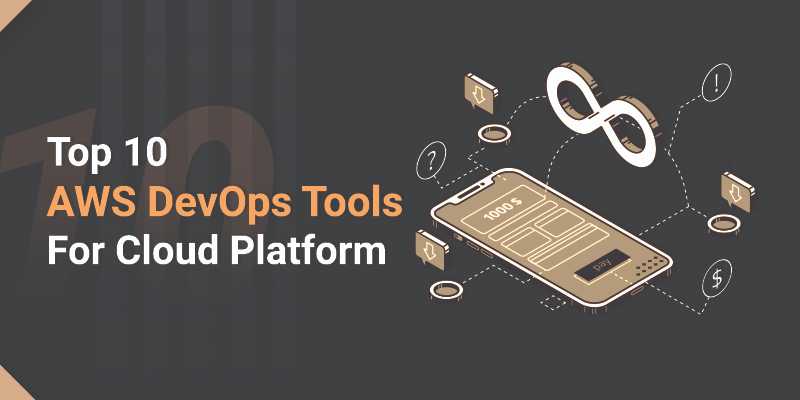AWS offers a collection of customizable services that allow businesses to create and deliver products more quickly and efficiently by combining AWS with DevOps methods. Providing and maintaining architecture, delivering source code, managing product release procedures, and evaluating the implementation of your software and infrastructural facilities are all made easier with these services.
DevOps is a set of cultural ideas, practices, and technologies that improves an organization’s capacity to provide elevated software and services, allowing it to evolve and improve products at a quicker rate than traditional methods of software production and infrastructure management procedures. AWS DevOps course will help you learn and implement your DevOps skills on AWS.
AWS DevOps provides a wide range of tools for developing and deploying applications in the cloud. These tools are categorized into various practices which will be discussed further. We are also going to see organizations using these tools.
Continuous Integration and Continuous Delivery
Continuous Integration and Continuous Delivery is crucial in the software development process. The following tools provided by AWS will assist in building CI/CD workflow.
1. AWS CodePipeline
AWS CodePipeline is a continuous integration and delivery solution for updating applications and infrastructures quickly and reliably. Depending on the releasing process models you describe, CodePipeline creates, evaluates, and releases your code each time there is a code update. This allows you to deploy features and upgrades quickly and consistently. Lululemon uses AWS CodePipeline to publish artifacts delivered through Amazon S3.
2. AWS CodeBuild
AWS CodeBuild is a highly scalable continuous integration platform that compiles code, performs tests, and generates fully prepared software programs. You don’t have to build, maintain, or grow your individual building server with CodeBuild.
3. AWS CodeDeploy
Code releases to any server, even Ec2 Instances, and on-premises servers, are automated with AWS CodeDeploy. AWS CodeDeploy makes it simpler to quickly deliver new features, prevent failures during deploying applications, and manage the intricacy of application updates. Instacart utilizes AWS CodeDeploy to automate deployments.
4. AWS CodeStar
AWS CodeStar is a streamlined interface that helps you to control all of your software design operations from a single location. You can build up your whole continuous deployment toolchain in minutes using AWS CodeStar, so you can start delivering code sooner.
Microservices
You can create and deploy a microservices architecture with the following AWS DevOps tools.
5. Amazon Elastic Container Service
It’s tightly integrated with the rest of the AWS platform. So, if you want to utilize containers at a certain point in your development, Amazon ECS will make it simple to run Docker containers on a scalable cluster. Coursera manages a microservices-based architecture for its applications with Amazon Elastic Container Service.
6. AWS Lambda
You can use Lambda to deliver code without having to construct a typical infrastructure from the bottom up. The only thing you have to do now is submit the application software, and the rest will be set up according to the use and scalability guidelines that have been supplied. Localytics creates microservices with AWS Lambda that ingest 100 billion data streams each month.
Infrastructure as Code
This practice sets up and administers your AWS cloud services by creating machine-readable and templates. AWS CloudFormation and AWS OpsWorks are the most preferable AWS DevOps tools for Infrastructure as code.
Read next: Trending Series on Amazon Prime to Lift Your Mood
7. AWS CloudFormation
AWS CloudFormation makes it simple for development teams to establish and manage a group of linked AWS resources, providing and upgrading these in a consistent and effective way. You can use the example templates provided by AWS CloudFormation or develop yourself. Simpl used AWS CloudFormation to automate procedures that previously took months to complete.
8. AWS OpsWorks
AWS OpsWorks is a managed services solution that offers Chef and Puppet administered servers. Chef and Puppet are automation systems that enable you to automate servers using code. The Toronto Star decreased the time it took to deploy their data management application from 3 hours to 20 minutes by utilizing AWS OpsWorks, saving money and increasing efficiency.
Monitoring and Logging
To ensure that actions are generated at the appropriate times and to rectify anything that’s not working properly, all systems activities must be watched and documented. Whenever it concerns watching, recording, and data collecting, the Amazon CloudWatch tool will make things easier
9. Amazon CloudWatch
Amazon CloudWatch may be used to gather and record metrics, analyze system logs, trigger alerts, and proactively respond to variations in your AWS resources. The Globe and Mail utilized Amazon CloudWatch to track system performance and employed a DevOps strategy to automate infrastructures.
Read next: Things to Learn About While Investing in Amazon
Platform as a Service
If you want to create a hybrid cloud environment, you may use AWS as a PaaS service. Web apps may be deployed without having to provide and maintain the infrastructure and software stack.
10. AWS Elastic Beanstalk
AWS Elastic Beanstalk is a simple solution for building and expanding web services on Amazon Web Services. just upload code, and Elastic Beanstalk will take care of everything else, including supplies, bandwidth allocation, auto-scaling, and application monitoring systems. Rachio deploys and manages its website, applications, and APIs using AWS Elastic Beanstalk.







